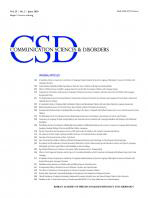- 영문명
- Development of Core Lexicon Lists for Cognitively Healthy Adults across Age Groups in a Korean Storytelling Task
- 발행기관
- 한국언어청각임상학회
- 저자명
- 박지민(Jimin Park) 최수진(Sujin Choi) 김소은(So Eun Kim) 김하나(Hana Kim) 성지은(Jee Eun Sung)
- 간행물 정보
- 『Communication Sciences & Disorders』vol30. no.3, 579~592쪽, 전체 14쪽
- 주제분류
- 사회과학 > 교육학
- 파일형태
- 발행일자
- 2025.09.30
4,480원
구매일시로부터 72시간 이내에 다운로드 가능합니다.
이 학술논문 정보는 (주)교보문고와 각 발행기관 사이에 저작물 이용 계약이 체결된 것으로, 교보문고를 통해 제공되고 있습니다.

국문 초록
배경 및 목적: 본 연구는 한국어 사용자에게 친숙한 전래동화를 활용하여, 연령 집단(청년층, 중장년층, 노년층)별 핵심 명사 및 동사목록을 개발하는 것을 목적으로 하였다. 이를 통해 담화 과제 수행 시 연령에 따른 어휘 선택 차이를 분석하고, 핵심 어휘 목록 분석이임상에서 활용 가능한 담화 평가 방법으로서 타당한지를 검증하고자 하였다. 방법: 본 연구에는 인지적으로 건강한 한국인 성인 180명(각 연령 집단별 60명)이 참여하였다. 참여자들은 8컷으로 구성된 ‘흥부놀부’ 이야기 그림을 기반으로 이야기하기 과제를 수행하였으며, 산출된 담화는 전사하여 분석하였다. 각 연령 집단 내에서 40% 이상이 산출한 명사 및 동사는 핵심 어휘로 선정하였다. 집단 간 산출 어휘의 일치도를 산출하였으며, 연령 집단별로 차별화되는 명사 및 동사를 도출하기 위해 LASSO 로지스틱 회귀 분석을 실시하였다. 결과: 핵심 명사 일치도는 76.47%에서 93.33% 사이였던 반면, 핵심 동사 일치도는 더 낮아 50.00%에서 72.73% 사이였다. 명사 ‘형수/형수님’과 동사 ‘켜다’는 청년층과 중장년층, 청년층과 노년층을 구분하는 항목으로 나타났다. 반면, 중장년층과 노년층을 구분하는 항목으로는 명사 ‘동생/아우’만이 나타났으며, 구분되는 동사는 확인되지 않았다. 논의 및 결론: 본 연구는 한국어 담화 과제에서 연령 집단별 핵심 명사 및 동사 목록을 최초로 개발한 연구이다. 연구 결과는 청년층과 노년층 간 어휘 사용에서 유의미한 연령 차이가 존재함을보여주었으며, 한국어 담화 평가를 위해 연령 집단별 핵심 어휘 목록을 체계적으로 구축할 필요성과 그 타당성을 강조한다.
영문 초록
Objectives: This study aimed to develop core noun and verb lists by age groups (young, middle-aged, and older adults) using a familiar Korean folktale. It sought to examine age related differences in lexical selection during discourse tasks and to establish the validity of core lexicon analysis as a clinically applicable method for discourse evaluation. Methods: A total of 180 cognitively healthy Korean adults (60 per age group) participated in a storytelling task based on an 8-picture sequence depicting “Heungbu and Nolbu.” Participants’ narratives were transcribed, and core nouns and verbs were identified if produced by at least 40% of participants within each group. Percent agreement between groups was calculated, and LASSO logistic regression analyses were performed to identify age group-differentiating lexical items for nouns and verbs. Results: Core noun agreement ranged from 76.47% to 93.33%, whereas core verb agreement was lower, ranging from 50.00% to 72.73%. The noun ‘sister-in-law’ and the verb ‘split’ served as distinguishing items in the comparisons between the young and middle-aged groups, as well as between the young and older groups. In contrast, only the noun ‘younger brother’ differentiated the middle aged and older groups, with no distinguishing verbs identified. Conclusion: This study is the first to develop age-specific core noun and verb lists in Korean discourse tasks. The findings highlight significant age-related differences in lexical usage, particularly between young and older adults. These results underscore the necessity and validity of establishing age-specific core lexicon lists for Korean, which can enhance clinical discourse assessment.
목차
연구방법
연구결과
논의 및 결론
REFERENCES
해당간행물 수록 논문
- 아동의 미디어 기기 중독이 화용 언어 능력에 미치는 영향에서 집행기능 곤란의 매개효과
- 학령전기 자폐스펙트럼장애 아동의 자발화 표현에서의 용언 사용
- 자폐 스펙트럼장애(ASD) 및 주의력결핍 과잉행동장애(ADHD) 아동의 화용언어와 내재화 및 외현화 행동 간의 연관성
- 미숙아의 초기 발성이 이후 언어 발달에 미치는 영향: 생후 12-24개월의 종단 연구
- 무의미낱말 따라말하기 과제를 통한 유아의 음운발달 탐색
- 4세 언어발달지연 아동의 소근육운동발달과 언어발달 간의 상관관계 및 예측력
- 3-6세 유아의 언어발달지연 출현율: 인구기반연구
- 취학전 문해고위험군, 복합문해고위험군의 낱말 읽기 및 쓰기 수행력: 의미유무와 음절 내 위치를 고려하여
- 말소리장애 하위유형에 따른 음운표상 능력
- 초등 2학년 난독 학생의 해독난이도에 따른 문단글 읽기유창성 발달 및 오류 특성
- 묘사와 설명 글쓰기를 통해 종단적으로 살펴본 초등 저학년의 쓰기 발달: 생산성과 어휘를 중심으로
- 언어장애 아동을 대상으로 한 어휘중재 단일대상연구의 메타분석: 효과크기 및 질적지표 분석
- 한국 아동 대상 간편 행동억제기질검사 ‘Short Behavioral Inhibition Scale’의 표준화 연구
- 한국어 이야기 말하기 과제 기반 연령대별 정상 성인의 핵심 어휘 목록 개발
- 성별에 따른 고령자의 담화 산출에서의 거시구조 및 미시구조의 차이
- AbSANT (Abstract Semantic Associative Network Training) 중재가 실어증 환자의 이름대기 능력에 미치는 효과
- Effects of Images on Word Training in Persons with Aphasia: An Exploratory Study
참고문헌
교보eBook 첫 방문을 환영 합니다!

신규가입 혜택 지급이 완료 되었습니다.
바로 사용 가능한 교보e캐시 1,000원 (유효기간 7일)
지금 바로 교보eBook의 다양한 콘텐츠를 이용해 보세요!



